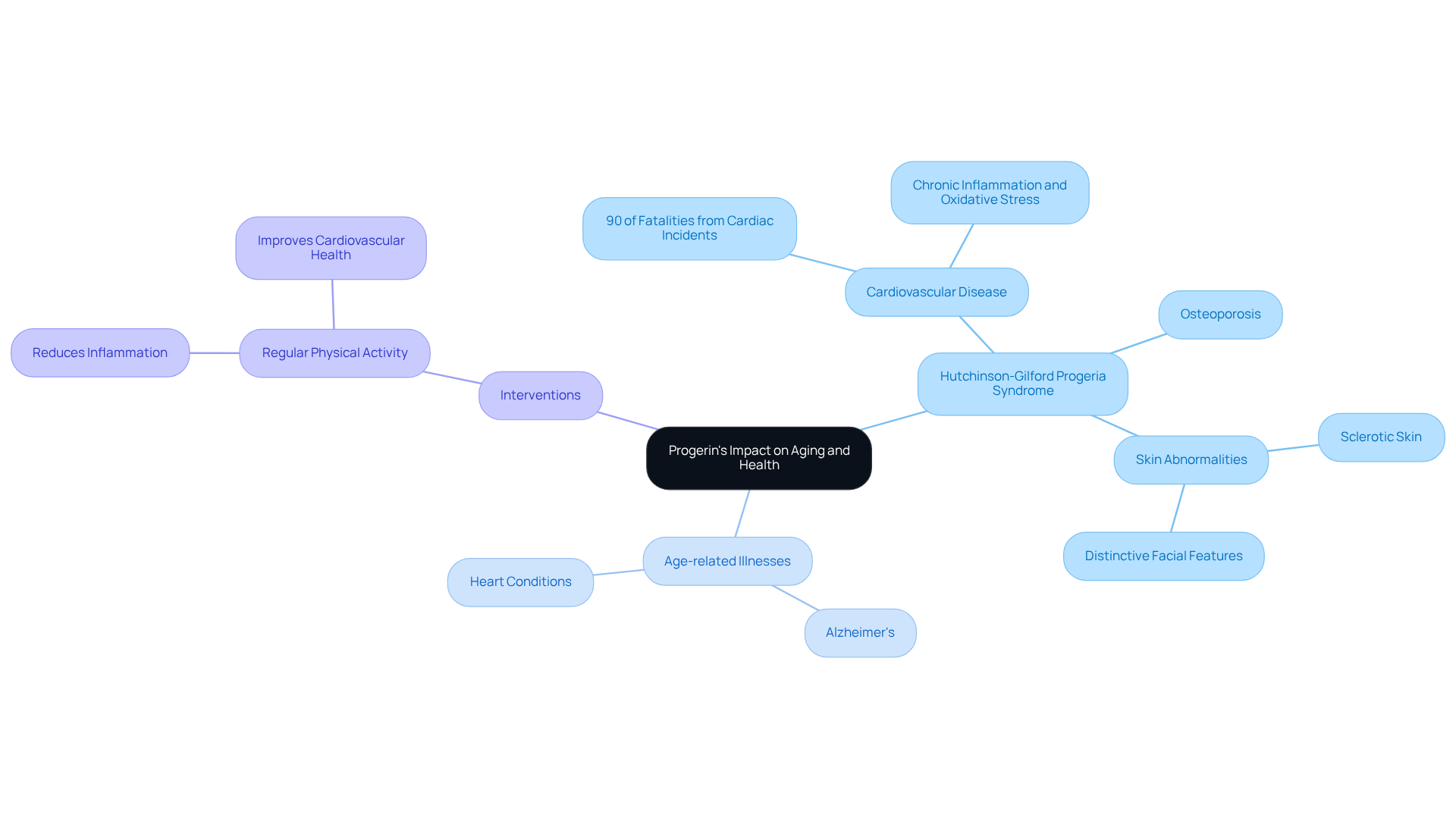Progerin: Understanding Its Role in Cellular Aging and Health
Overview
Progerin is a pivotal factor in cellular aging and health, significantly disrupting nuclear structure and contributing to age-related diseases, especially in conditions like Hutchinson-Gilford Progeria Syndrome (HGPS). This accumulation of progerin is linked to increased DNA damage and cellular senescence, both of which are fundamental aspects of aging. Furthermore, research suggests that interventions such as dietary modifications and targeted treatments can alleviate these detrimental effects, promoting healthier aging outcomes.
What if simple lifestyle changes could enhance your longevity? By understanding the impact of progerin on our cells, we can explore practical steps to mitigate its effects. Engaging in specific dietary practices and considering medical interventions may not only slow down the aging process but also improve overall health.
In conclusion, addressing progerin’s role in aging opens the door to innovative strategies for healthier living. By staying informed about these developments, individuals can take proactive steps towards better health as they age.
Introduction
The intricate dance of cellular aging is influenced by a myriad of factors, with progerin—a truncated form of the lamin A protein—standing out due to its profound biological implications. Researchers are delving into the mechanisms behind progerin’s role in cellular deterioration, uncovering its dual presence in both Hutchinson-Gilford Progeria Syndrome and normal aging. This reveals critical insights into age-related diseases.
What strategies can be employed to mitigate the detrimental effects of progerin and promote healthier aging? This exploration not only highlights the significance of progerin in health outcomes but also opens the door to innovative therapeutic interventions. These interventions could reshape our understanding of aging itself.
Define Progerin and Its Biological Significance
An abnormal isoform of the lamin A protein known as progerin results from a mutation in the LMNA gene. This mutation produces a truncated form of lamin A that accumulates in cells, particularly in those affected by Hutchinson-Gilford Progeria Syndrome (HGPS). The significance of this protein lies in its ability to disrupt normal nuclear structure, leading to instability within cells and early onset of age-related changes.
Importantly, progerin is prevalent not only in HGPS but also in regular maturing cells. This highlights its essential role in understanding the aging process at the cellular level. Studies have demonstrated that this protein contributes to numerous age-associated illnesses by promoting DNA damage and cellular senescence, which are characteristic features of aging. For instance, research indicates that increased oxidative stress and inflammation correlate with the expression of progerin, exacerbating age-related disorders.
Furthermore, specific studies reveal that levels of progerin are significantly elevated in patients with non-proliferative diabetic retinopathy compared to those with proliferative types. This suggests its potential role as a biomarker for senescence and vascular health. Additionally, treatment with the farnesyltransferase inhibitor lonafarnib has shown an average reduction of 35%-62% in the abnormal protein, indicating a promising therapeutic intervention.
Recent studies, including Dr. Dituri’s innovative underwater experiment, suggest that extended underwater living may influence biological processes and related factors. By examining lifestyle changes, such as dietary adjustments and physical activity, alongside unique environments like those created in underwater settings, we can gain valuable insights into the mechanisms of aging and the potential for innovative therapies.
Overall, progerin serves as a crucial element in the intersection of cellular deterioration and health, warranting further investigation into its mechanisms and implications for treatment approaches.
Explore Mechanisms of Progerin-Induced Cellular Aging
The aging of cells involves various mechanisms in which progerin plays a pivotal role. It disrupts the normal architecture of the nuclear envelope, resulting in nuclear blebbing and instability. This structural compromise significantly increases the likelihood of DNA damage, particularly through the heightened occurrence of unrepaired double-strand breaks. Research indicates that this protein also adversely affects telomere function, leading to accelerated telomere shortening, a process closely linked to cellular senescence.
Furthermore, the presence of progerin impairs stem cell functionality, hindering tissue regeneration and maintenance. Notably, it binds to PCNA, altering its distribution away from replicating DNA, which exacerbates DNA repair deficiencies. Collectively, these mechanisms contribute to the phenotypic traits linked to aging, such as diminished cellular proliferation and increased stiffness, which are evident in both Hutchinson-Gilford Progeria Syndrome (HGPS) and normal senescence due to the presence of progerin.
Recent studies, including those from Dr. Joseph Dituri’s underwater research, suggest that exposure to unique underwater environments may influence telomere length and overall well-being evaluations. This could potentially offer innovative anti-aging strategies. Comprehending these pathways is essential for creating focused strategies intended to alleviate the impacts of specific proteins and encourage healthier maturation.
Discuss Progerin’s Impact on Aging and Health Outcomes
The buildup of progerin significantly impacts longevity and wellness outcomes, particularly in individuals with Hutchinson-Gilford Progeria Syndrome (HGPS). In these patients, the associated protein accelerates signs of deterioration, leading to severe cardiovascular disease, osteoporosis, and distinctive skin abnormalities. Notably, studies indicate that nearly 90% of fatalities among HGPS individuals result from cardiac incidents, underscoring the crucial role of this protein in cardiovascular health.
Moreover, in the broader elderly population, this protein is linked to various age-related illnesses, including Alzheimer’s and other heart conditions. Research suggests that it exacerbates inflammation and oxidative stress, which are key contributors to the decline in health associated with aging. For instance, individuals who engage in regular physical activity can mitigate some adverse effects of certain proteins, as exercise has been shown to reduce inflammation and improve cardiovascular health.
Understanding the role of progerin in these contexts is essential for developing targeted treatments that may promote healthier aging and potentially extend lifespan. As researchers delve deeper into the mechanisms through which this protein affects health, the prospect of innovative therapies aimed at reducing its accumulation appears increasingly promising.

Identify Strategies to Mitigate Progerin Effects
To effectively reduce the impacts of this protein, a multifaceted approach can be adopted, reflecting the principles of healthy aging promoted by ByKomi.com. Nutritional interventions play a crucial role; diets rich in antioxidants and anti-inflammatory foods are essential for reducing oxidative stress associated with the buildup of certain proteins. Essential nutrients like vitamin D and omega-3 fatty acids have shown considerable advantages for cell health. Research suggests that vitamin D can improve DNA repair processes and reduce levels of harmful proteins in impacted cells. For example, extended therapy with 1,25D has been demonstrated to stabilize DNA repair factors and decrease progeria expression in Hutchinson-Gilford progeria syndrome (HGPS) cells, resulting in enhancements in nuclear morphology and a decline in DNA damage.
In addition to dietary changes, lifestyle modifications, including regular exercise, are vital as they promote cellular repair processes and overall vitality. New treatments, especially farnesyltransferase inhibitors (FTIs) such as lonafarnib, have demonstrated potential in clinical trials by significantly lowering levels of progerin and enhancing patient outcomes. For instance, in the ProLon1 trial, patients receiving lonafarnib showed an average reduction of 38% from baseline in a specific protein, which was linked to enhanced survival rates.
Furthermore, antioxidants such as sulforaphane, found in cruciferous vegetables, have been linked to enhanced proteasome activity and a decrease in progerin levels. Karima Djabali noted that sulforaphane treatment leads to more efficient DNA repair in HGPS cells, suggesting a synergistic effect when combined with other treatments. By integrating these nutritional and lifestyle strategies, individuals can effectively combat the aging process and enhance their overall health, aligning with the principles of healthy aging advocated by ByKomi.com. Additionally, drawing inspiration from the Hunza people’s longevity, which emphasizes a balanced diet and active lifestyle, can further enrich these anti-aging strategies.
Conclusion
Progerin plays a pivotal role in cellular aging, serving as a critical factor in both Hutchinson-Gilford Progeria Syndrome and the natural aging process. Its presence disrupts cellular structures and promotes age-related diseases, underscoring the importance of understanding this protein in the context of health and longevity.
The article highlights how progerin contributes to various mechanisms of cellular degradation, including:
- DNA damage
- Impaired stem cell function
It discusses significant health outcomes associated with progerin, such as:
- Cardiovascular diseases
- Cognitive decline, particularly in aging populations
Furthermore, it explores promising strategies to mitigate progerin’s effects through:
- Nutritional interventions
- Lifestyle changes
- Emerging therapies
This emphasizes the potential for improving health outcomes.
In light of these insights, prioritizing research and awareness surrounding progerin and its implications for aging is essential. By adopting healthy lifestyle choices and exploring innovative treatments, individuals can take proactive steps toward reducing progerin levels and enhancing their overall well-being. The journey to healthier aging is not only about understanding the biological processes at play but also about implementing actionable strategies that can lead to significant improvements in quality of life.
Frequently Asked Questions
What is progerin?
Progerin is an abnormal isoform of the lamin A protein that results from a mutation in the LMNA gene, producing a truncated form of lamin A that accumulates in cells.
What is the biological significance of progerin?
Progerin disrupts normal nuclear structure, leading to cellular instability and early onset of age-related changes. It plays a crucial role in understanding the aging process at the cellular level.
In which conditions is progerin particularly prevalent?
Progerin is notably prevalent in Hutchinson-Gilford Progeria Syndrome (HGPS) and also in regular maturing cells.
How does progerin contribute to age-associated illnesses?
Progerin promotes DNA damage and cellular senescence, which are characteristic features of aging, and is associated with increased oxidative stress and inflammation that exacerbate age-related disorders.
What is the relationship between progerin and diabetic retinopathy?
Studies have shown that levels of progerin are significantly elevated in patients with non-proliferative diabetic retinopathy compared to those with proliferative types, suggesting its potential role as a biomarker for senescence and vascular health.
What therapeutic intervention has shown promise in reducing progerin levels?
Treatment with the farnesyltransferase inhibitor lonafarnib has demonstrated an average reduction of 35%-62% in progerin levels, indicating a potential therapeutic approach.
What recent studies have explored the effects of environment on aging?
Recent studies, including Dr. Dituri’s underwater experiment, suggest that extended underwater living may influence biological processes related to aging, providing insights into mechanisms and potential therapies.
Why is progerin important for future research?
Progerin serves as a crucial element in understanding the intersection of cellular deterioration and health, warranting further investigation into its mechanisms and implications for treatment approaches.






